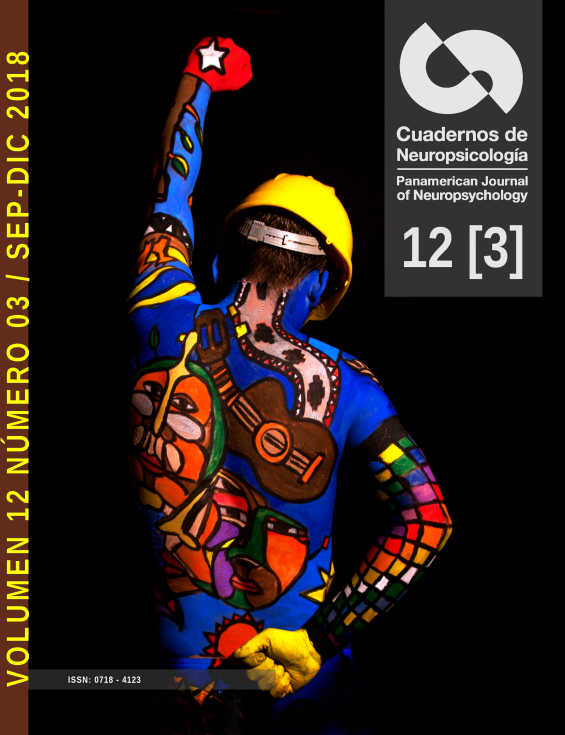Doble disociación entre el reconocimiento y la expresión de la prosodia en pacientes con accidente cerebrovascular
Abstract
Resumen
Objetivo: Presentar el rendimiento de cuatro pacientes (1JB, 2NJ, 3MA y 4SQ) con lesiones isquémicas (ACV) del hemisferio derecho (HD) que muestran disociaciones dobles entre la capacidad para reconocer y expresar prosodia lingüÃstica y emocional. Método: Se evaluó a los pacientes con cuatro pruebas de reconocimiento y producción de prosodia emocional y lingüÃstica y se comparó el rendimiento contra un grupo control sano (n = 15). Se analizaron las disociaciones entre el reconocimiento y la producción con los criterios operacionalizados de Crawford y Garthwaite. Resultados: Respecto de la prosodia emocional, la paciente 3MA mostró alteración del reconocimiento pero no de la expresión, mientras que el paciente 4SQ presentó el patrón opuesto. En cuanto a la prosodia lingüÃstica, el paciente 1JB mostró alteración del reconocimiento pero no de la expresión, mientras que el paciente 2NJ tuvo el patrón inverso. Discusión: Los patrones conjuntos de los pacientes evidencian disociaciones dobles entre la capacidad de reconocer y expresar prosodia emocional y lingüÃstica en pacientes con ACV del HD.
Palabras clave: prosodia; hemisferio derecho; disociaciones; múltiples casos únicos.
Â
Abstract
Objective: We present four cases of patients (1JB, 2NJ, 3MA and 4SQ) with ischemic strokes of the right hemisphere (HD) with dissociations between the ability to recognize and express prosody. Method: The patients were evaluated with four tests of recognition and expression of emotional and linguistic prosody and the performance was compared against a healthy control group (n = 15). The dissociations between recognition and expression were analyzed with the operationalized Crawford and Garthwaite criteria. Results: Regarding the emotional prosody, the patient 3MA presented alteration in the recognition but not in the expression, while the patient 4SQ presented the opposite pattern. On the other hand, in relation to linguistic prosody, patient 1JB had altered the recognition but not the expression, while patient 2NJ had the inverse pattern. Discussion: Both patterns of the patients showed double dissociations between the ability to recognize and express emotional and linguistic prosody in patients with ischemic stroke of the right hemisphere.
Key words: prosody; right hemisphere; dissociations; multiple case series.
Â
Resumo
Objetivo: Apresentar o rendimento de quatro pacientes (1JB, 2NJ, 3MA e 4 SQ) com lesões isquêmicas (ACV) do hemisfério direito (HD) com dissociações duplas entre a capacidade de reconhecer e expressar prosódia linguÃstica e emocional. Método: Os pacientes foram avaliados com quatro provas de reconhecimento e produção de prosódia emocional e linguÃstica. Os resultados de rendimento foram comparados com os de um grupo de controle saudável (n=15). Com os critérios operacionalizados de Crawford e Garthwaite realizou-se a análise das dissociações entre o reconhecimento e a produção. Resultados: Em relação com a prosódia emocional, o paciente 3MA demonstrou alteração do reconhecimento, mas não da expressão, enquanto ocorreu o padrão oposto no paciente 4SQ. No diz respeito a prosódia linguÃstica, o paciente 1JB apresentou alteração do reconhecimento, porém não da expressão, o padrão inverso foi encontrado no paciente 2NJ. Analise de Resultados: Os padrões conjuntos dos pacientes evidenciam dissociações duplas entre a capacidade de reconhecer e expressar prosódia emocional e linguÃstica em pacientes om ACV do HD.
Palavras-chave: prosódia; hemisfério direito; dissociações; múltiplos casos únicos.
Downloads
How to Cite
Issue
Section
License
Articles published in this journal are protected under the Creative Commons Attribution-NonCommercial-ShareAlike 4.0 International (CC BY-NC-SA 4.0) license. This means that authors retain full rights over their research and publications at all times. As a journal, we fully respect and promote the principles of open access established by this license, allowing the work to be shared, adapted, and distributed for non-commercial purposes, provided that appropriate credit is given to the authors and any derivative works are licensed under the same terms.
Authors are responsible for obtaining the required permission when they wish to reproduce part of the material (figures, etc.) from other publications.
Likewise, CNPs allows authors to host in their personal sites or other repositories that they deem convenient the Final and Definitive Version of the published article with the format assigned by the journal. In no case do we allow access to preprints of the article under evaluation or already published.
When submitting an article to CNPs you are aware that all the contents of CNPs are under a Creative Commons License. In which it is allowed to copy and share the contents freely, always making reference to the origin of the publication and its author.





